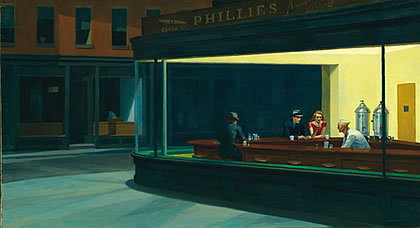Edward Hopper
dal 15/9/2007 al 20/1/2008
Segnalato da
15/9/2007
Edward Hopper
National Gallery of Art, Washington
The classic works of Edward Hopper capture the realities of urban and rural American life with a poignancy and beauty that have placed them among the most enduring and popular images of the 20th century. This exhibition of about 50 oil paintings, 25 watercolors, and 12 prints, arranged chronologically and thematically, reveals the artist as a creator of compelling images who produced remarkably subtle and painterly effects in both oil and watercolor. It will also examine how his images were seen by his contemporaries in the middle decades of the century.

Retrospective
curated by Carol Troyen, John Moors Cabot
The exhibition Edward Hopper marks the first time in more than 25 years—in the case of Boston and Washington, more than 50—that a comprehensive exhibition of this great artist's work has been seen in American museums outside New York. This comprehensive survey will focus on the period of the artist's great achievements—from about 1925 to mid-century—when he produced such iconic paintings as Automat (1927), Drug Store (1927), Early Sunday Morning (1930), New York Movie (1939), and Nighthawks (1942).
Edward Hopper is organized by the Museum of Fine Arts, Boston, where it debuts May 6 through August 19, 2007; the National Gallery of Art, Washington, where it will be on view September 16, 2007 through January 21, 2008; and The Art Institute of Chicago, where it will be seen February 16 through May 11, 2008.
"The National Gallery is pleased to present this new exploration of a very fertile period in Edward Hopper's career when he produced some of the outstanding masterpieces of modern American art," said Earl A. Powell III, director, National Gallery of Art. "We are pleased to join the Museum of Fine Arts and the Art Institute of Chicago in investigating how his images were seen in his own time. We welcome the sponsorship of Booz Allen Hamilton, who helped bring this important show to our nation's capital."
Exhibition Organization and Sponsor
The exhibition at the National Gallery of Art in Washington is made possible by a generous grant from the global consulting firm Booz Allen Hamilton Inc.
"Booz Allen is honored to sponsor this major exhibition at the National Gallery of Art of one of America's greatest artists. Edward Hopper's genius was his ability to make ordinary and familiar scenes into extraordinary and memorable ones. This exhibition will delight and inspire people of all ages in the Washington area, and we are proud to be able to help make possible such a special exhibition where our firm is headquartered," said Dr. Ralph Shrader, chairman and chief executive officer of the global consulting firm Booz Allen Hamilton.
The Artist and the Exhibition
The classic works of Edward Hopper (1882-1967) capture the realities of urban and rural American life with a poignancy and beauty that have placed them among the most enduring and popular images of the 20th century. This exhibition of about 50 oil paintings, 25 watercolors, and 12 prints, arranged chronologically and thematically, reveals Hopper as a creator of compelling images who produced remarkably subtle and painterly effects in both oil and watercolor. It will also examine how his images were seen by his contemporaries in the middle decades of the century.
From the late 1920s, Hopper was recognized as one of the most profound American artists, praised for his mastery at painting light, for his direct, eloquent realism, and for his unique sensitivity to modern American life. He excelled as a painter in oils, as a watercolorist, and as a printmaker, and this exhibition presents his greatest work in all three media. The assembled art includes some of Hopper's best-loved images as well as seldom seen works of extraordinary quality and power.
A group of paintings and prints from the late 1910s and early 1920s introduces his signature subjects, and reveals his beginnings as an artist influenced by both the American Ashcan school and a fin-de-siècle sensibility to which he was exposed during student years in Paris. The core of the exhibition is dedicated to the mature, highly original images for which he is justly famous: majestic Maine lighthouses; Manhattan apartments, restaurants, and theaters; and the old-fashioned houses of Gloucester and Cape Cod. Hopper's career spanned six decades, and in his epic late paintings, created during the ascendancy of abstract expressionism, he remained a staunch realist, his style marked by increasing simplicity and austerity.
Documentary Film
A documentary film about Hopper's career produced by the National Gallery of Art will accompany the exhibition at all three venues and will be aired on PBS-TV stations nationwide. The production includes present-day views of Hopper's subjects and interviews with Carol Troyen, exhibition curator; friends of Hopper's; and Red Grooms and Eric Fischl, artists influenced by Hopper. The film is made possible by the HRH Foundation.
Curators, Catalogue, and Related Activities
A fully illustrated catalogue will be published by the Museum of Fine Arts, Boston and will be available in both softcover ($45.00) and hardcover ($65.00) editions. The catalogue will include essays by the co-curators of the exhibition—Carol Troyen, John Moors Cabot Curator of American Paintings, Museum of Fine Arts, Boston and Judith Barter, The Field-McCormick Chair of American Art at The Art Institute of Chicago—and others and will be available for sale by the National Gallery of Art Shops in May. The catalogue will be approximately 288 pages with 170 color and 15 black-and-white illustrations.
A full program of lectures, music, and other events will be announced by the Gallery at a later date.
National Gallery of Art
6th Street and Constitution Avenue - Washington
Monday through Saturday from 10:00 a.m. to 5:00 p.m. and Sunday from 11:00 a.m. to 6:00 p.m.



